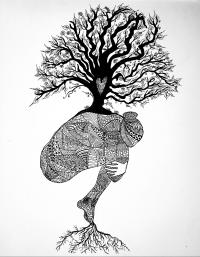Mother Trees In A Wood Wide Web


Elders fill a special role in any community, having earned the respect of the tribe for their life-long wisdom, knowledge, and teaching. They help link individuals to the broader community as a whole, and connect the past with the future. Not all old individuals are elders, nor are all elders old. In my family, grandmothers and grandfathers usually filled the role of elders, although certain individuals, like my daughters, were born with wisdom beyond their years, connecting the family through the ages. This wisdom emerges from lives lived before them over many generations.
In my life’s work in the forest, I have learned that elders of many species, including humans, also connect the forest, providing an adaptive genetic scaffolding for change and resilience among the whole community. In the forest, the foundational species are the trees, and the elders of this foundation are the biggest and oldest trees. Elder trees provide an anchor for the diverse structure of the many-sized trees in their neighborhoods. These elders are important not just as habitat for the many plant, animal, fungal, and microbial creatures that live in the forest, but also the people who depend on the woods for their cultures and livelihoods.
A single elder Douglas fir tree, for example, can be connected to hundreds of other trees, either of the same or different species, by the sheer magnitude of its massive root system and diverse fungal community. These subterranean connections form a mycorrhizal network, now known colloquially as the “Wood Wide Web,” with a topology similar to that of neural networks, stream networks in watersheds, and the internet. In the Wood Wide Web, trees can be thought to serve as the nodes of the network, while fungi act as the vertices.
The Wood Wide Web is a busy network, where [...] elder trees are able to recognize neighbors that are genetically related, or that are kin, and they can send more or less resources to other trees to either favor or disfavor them, depending on the safety of the environment. I have taken to calling these elders “Mother Trees” because they appear to be nurturing their young. Mother Trees thus connect the forest through space and time, just like elders connect human families across generations.
Suzanne Simard is a Canadian scientist, professor and author various books. Excerpted from this article.
SEED QUESTIONS FOR REFLECTION: How do you relate to the connecting and nurturing role of elders, be they humans or trees? Can you share an experience of a time you became aware of an entire ecology beneath the visible nodes? What helps you be a nourishing elder that sustains others?
Add Your Reflection
8 Past Reflections

On Oct 16, 2021 Debbie wrote :
Post Your Reply

On Oct 8, 2021 Gururaj wrote :
One such system that has influenced me is Yoga. A great master worked sincerely on himself, built institutions, which created expert instructors and one such instructor is coaching me well over more than a year. Health and peace spreads over all practitioners and , I trust, in some way it redounds to the glory of that original master.
Of course, weeds and noxious plants ( and inner impurities) also flourish, especially when the "elderly" forces are weak.These negative forces support each other and often become big forces - both externally in the world and in our psyches.
But maybe ( I trust) it's the innate love , wisdom, cleansing force of nature that eventually tips the evolution towards itself and the noxious things are kept in check.
Post Your Reply

On Oct 5, 2021 Megan McKenzie wrote :
There is one area you do not mention that I particularly treasure. The tall old elder trees showed me that they are receptors of cosmic energy and channel it into the earth.
The redwoods are a true elder community. Their roots are connected underground and above ground they frequently support each other with massive ingrown limbs.
They alsosupport a network of rare and endangered small species that are born on the tree and spend their entire life on that one tree.
The trees depend on fog for 90% of their water needs. It cannot possibly be pumped 200 ft.in the trunk. They truly are amazing miracles and gifts.
Post Your Reply

On Oct 5, 2021 Patrick wrote :
}:- a.m.
anonemoose monk
1 reply: J | Post Your Reply

On Oct 2, 2021 David Doane wrote :
Post Your Reply
